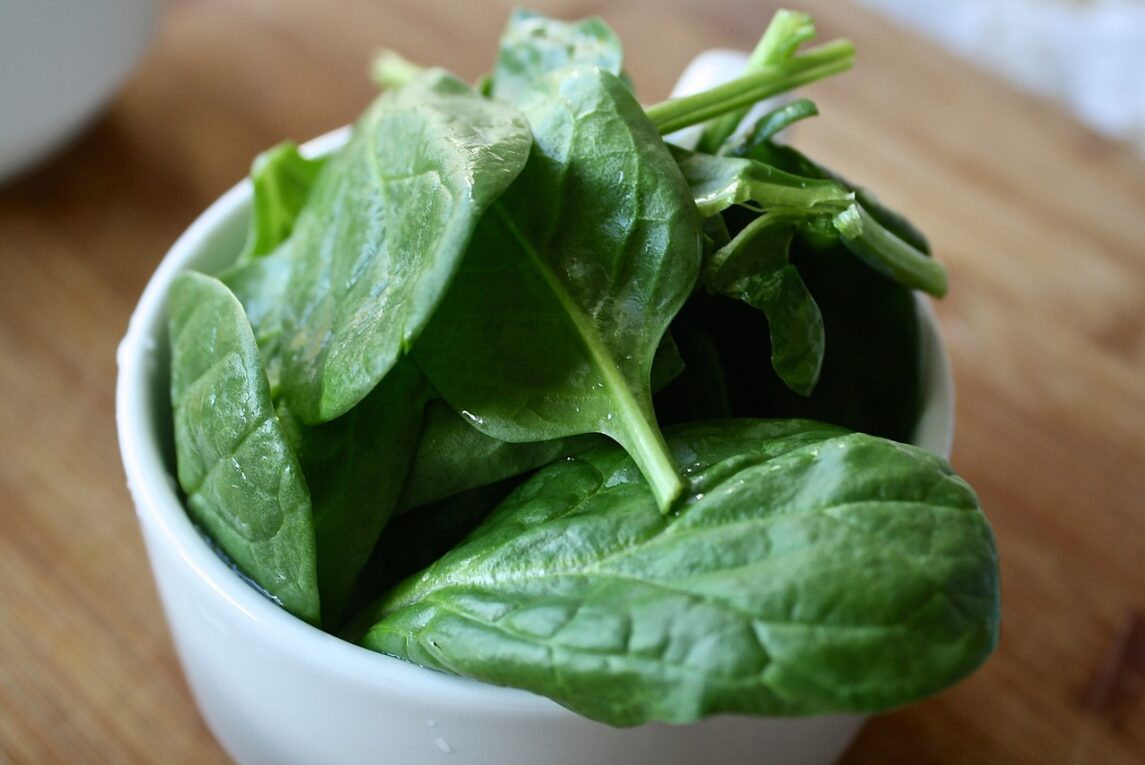Spinach, (Spinacia oleracea), is a leafy, dark-green vegetable well-known for its great nutritional quality and health-boosting properties. Spinach strengthens the body in a number of ways. Whilst it may not be the greatest tasting food in the world, spinach is very good for you because it’s full of vitamins and minerals. It would be wise to incorporate spinach into your diet.
Types of Spinach
The three basic types of spinach are:
- Savoy which has dark green, crinkly and curly leaves. It is the type sold in fresh bunches in most supermarkets. One heirloom variety of Savoy is Bloomsdale, which is somewhat resistant to bolting. Other common heirloom varieties are Merlo Nero (a mild variety from Italy) and Viroflay (very large spinach with great yields).
- Flat- or smooth-leaf spinach has broad, smooth leaves that are easier to clean than Savoy. This type is often grown for canned and frozen spinach, as well as soups, baby foods, and processed foods. Giant Noble is an example of the variety.
- Semi-Savoy is a hybrid variety with slightly crinkled leaves. It has the same texture as Savoy, but it is not as difficult to clean. It is grown for both fresh market and processing.
Background and Origin of Spinach
The common flowering-plant known as spinach is first believed to have been included in the diets of ancient Persians and naturally grows in Asia, specifically the central region. Belonging to the Amaranthaceae family, spinach can typically be described as having large, oval-shaped leaves that sprout from a relatively thick, central stalk that has clusters of small flowers growing at the tip.
The height of the plant usually maxes out at just over a foot tall, and the leaves can vary greatly in shape. The meaty leaves are the most common part to be eaten, but nearly the entire plant is edible.
Nutritional Content and Health Benefits of Spinach
Spinach is a highly nutritious leafy green vegetable that offers numerous health benefits when consumed as part of a balanced diet. It’s rich in vitamins, minerals, antioxidants and fiber, which contribute to overall health and well-being.
Spinach is considered a super-food due to its high nutritional value. Spinach contains a high amount of beta-carotene, the inactive stage of vitamin A. Beta-carotene is also found in many other leafy greens and yellow, red, and orange fruits and veggies, and it contributes to good vision, healthy skin, a strong immune system and reproductive system health. When beta-carotene is converted to vitamin A, more moisture is retained in the skin to keep it looking smooth and young.
Another important group of ingredients found in spinach is antioxidants. Antioxidants are believed to reduce the risk of getting cancer, heart disease and premature blindness. In spinach, vitamin A, vitamin E, vitamin C, zinc, selenium and manganese are all powerful antioxidants.
The list doesn’t stop there. Many other phytochemicals are found in Popeye’s favorite food, spinach. Specifically, lutein helps to lower the risk of losing sight at a faster than normal rate. Other notable vitamins and minerals found in spinach include:iron for hemoglobin production, vitamin C for immune strength, vitamin E for healthy skin, vitamin K for carboxylation and nervous system health, calcium for strong bones, potassium for heart health and normal blood pressure, dietary fiber for easy bowel movements and improved digestion, lipoic acid for the regulation of blood glucose levels and regeneration of various vitamins, and epoxy xanthophylls violaxanthin and neoxanthin for inflammation control.
As far as disease prevention goes, spinach is associated with a lower risk for cardiovascular disease, stroke, hardening of the arteries, high blood pressure, cancer and more.
Nutritional Content of a 1-Cup Serving Size of Raw Spinach
- Calories: 7
- Fat: 0 g
- Saturated Fat: 0 g
- Cholesterol: 0 mg
- Carbohydrate: 1 g
- Protein: 1 g
- Dietary Fiber: 1 g
- Sodium: 24 mg
- Vitamin A: 2,813 IU
- Folic Acid: 58 micrograms
- Vitamin C: 16 mg
- Iron: 1 mg
- Manganese: <1 mg
- Potassium: 167 mg
- Carotenoids: 5,347 micrograms
How to Take Spinach
Spinach can be prepared and consumed in a variety of different ways. The most common way to eat spinach is fresh and raw. Like with any other vegetable, all you need to do is rinse the spinach and enjoy it. Raw spinach can be combined with other vegetables and fruits to make a salad. This adds texture, taste and nutritional value as well. Spinach is also commonly eaten raw as part of a sandwich or blended in a smoothie.
Cooked spinach is commonly eaten in many dishes including pastas and meat dishes as a non-primary ingredient. It can also be served as a side dish to compliment a protein entree. When cooked, spinach wilts dramatically, becomes extremely tender and luscious, and loses much of its vitamin C content. Many people prefer to have it sauteed or steamed as opposed to eating it raw because it can be more flavorful.
If you are really opposed to the taste of spinach, the nutritional benefits can be had in a supplement form. Tablets or capsules are the most common form of supplementation.
Always take care when taking herbs and Read Our Disclaimer.
Spinach Notes / Side Effects
Like any food, excessive consumption of spinach or certain preparation methods may lead to potential side effects in some individuals.
Here are some considerations regarding the consumption of spinach:
Oxalate Content: Spinach contains oxalates, which are naturally occurring compounds found in many plant foods. Oxalates can bind to calcium and form insoluble crystals, potentially leading to the formation of kidney stones in susceptible individuals. If you have a history of kidney stones or are at risk of developing them, it may be advisable to limit your intake of high-oxalate foods like spinach.
Interaction with Medications: Spinach contains vitamin K, which plays a crucial role in blood clotting. If you are taking anticoagulant medications such as warfarin (Coumadin) to thin your blood, it’s important to maintain consistent vitamin K intake to avoid interfering with the medication’s effectiveness. While spinach is a good source of vitamin K, it’s best to consume it in moderation and maintain consistency in your dietary intake.
Risk of Foodborne Illness: Raw spinach, especially when consumed as part of salads or smoothies, may pose a risk of foodborne illness if not properly washed or handled. Spinach can harbor harmful bacteria such as E. coli and Salmonella, which can cause food poisoning. To reduce the risk of contamination, it’s essential to wash spinach thoroughly under running water before consumption and store it properly in the refrigerator.
Potential for Allergic Reactions: While uncommon, some individuals may be allergic to spinach or other leafy greens. Allergic reactions to spinach can range from mild symptoms such as itching, hives, or swelling to more severe reactions such as difficulty breathing or anaphylaxis in rare cases. If you experience any adverse reactions after consuming spinach, discontinue use and seek medical attention if necessary.
Interference with Thyroid Function: Spinach contains goitrogens, compounds that can interfere with thyroid function by inhibiting the uptake of iodine. While cooking can partially deactivate goitrogens, individuals with thyroid disorders or iodine deficiency may want to moderate their intake of raw spinach and other goitrogenic foods.
By consuming spinach in moderation and practicing proper food safety measures, you can enjoy its numerous health benefits while minimizing potential side effects. If you have specific health concerns or dietary restrictions, it’s advisable to consult with a healthcare professional or registered dietitian for personalized guidance.



Leave a Reply